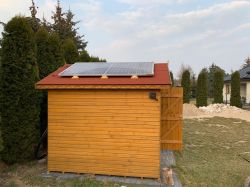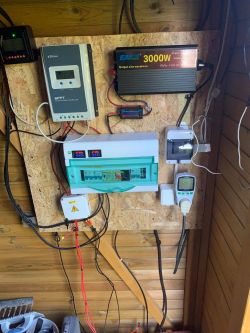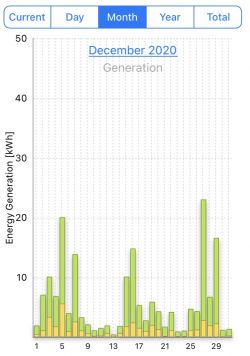Hello,
after many months of analysis, reading various topics on the forum and drawing conclusions, I managed to fulfill my little dream, which was to build a (partially) independent, automatically controlled OFF-GRID photovoltaic installation :)
My assumptions were as follows:
- supplying energy from PV panels during the day to receivers operating during the day (power supply for pumps and heating controls, cameras, alarm, modems, recuperation, fridge ...) - total power consumption is 200-250W
- storing surplus energy in batteries to be able to use it on cloudy days
- automatic switching of specific circuits between PV and the power industry, if no electricity flows from the PV installation
My installation consists of:
- 2 Longi panels with a power of 440W one
- Epever Tracer 4210AN charging controller
- AGM batteries operating in a 24v system with a total capacity of 1.4kWh
- 3000W pure sine inverter (1500W continuous power)
- fuses, measuring devices, etc...
- double-circuit relay switching circuits between photovoltaics and the power grid
The installation consists of 2 Longi panels with a power of 440W each, mounted on a woodshed in the east-west directions:

Everything is handled in my little command center Of course, I used the appropriate safeguards:
Of course, I used the appropriate safeguards:

From here, the current goes to the switchgear in a single-family house, where it controls a relay that switches specific circuits of receivers to power from photovoltaics (if the voltage from my "power plant" flows), instead of the power grid. Similarly, if my home "power plant" is not working, it is automatically switched to power from the power grid.
I plan to replace the batteries with LifePo4 from China with a total capacity of 2.4 kWh :)
So far, the system works great, unfortunately I am not able to store the entire surplus of electricity, because so far I consume about 1.2 kWh / day, taking into account that for the protection of the batteries, an automatic device is set to provide voltage to the house only in the hours of 7: 00 - 18:00. After replacing the batteries, I plan to power the house 24/7 with PV.
Below is a video where I briefly discuss the operation of my system:
after many months of analysis, reading various topics on the forum and drawing conclusions, I managed to fulfill my little dream, which was to build a (partially) independent, automatically controlled OFF-GRID photovoltaic installation :)
My assumptions were as follows:
- supplying energy from PV panels during the day to receivers operating during the day (power supply for pumps and heating controls, cameras, alarm, modems, recuperation, fridge ...) - total power consumption is 200-250W
- storing surplus energy in batteries to be able to use it on cloudy days
- automatic switching of specific circuits between PV and the power industry, if no electricity flows from the PV installation
My installation consists of:
- 2 Longi panels with a power of 440W one
- Epever Tracer 4210AN charging controller
- AGM batteries operating in a 24v system with a total capacity of 1.4kWh
- 3000W pure sine inverter (1500W continuous power)
- fuses, measuring devices, etc...
- double-circuit relay switching circuits between photovoltaics and the power grid
The installation consists of 2 Longi panels with a power of 440W each, mounted on a woodshed in the east-west directions:

Everything is handled in my little command center

From here, the current goes to the switchgear in a single-family house, where it controls a relay that switches specific circuits of receivers to power from photovoltaics (if the voltage from my "power plant" flows), instead of the power grid. Similarly, if my home "power plant" is not working, it is automatically switched to power from the power grid.
I plan to replace the batteries with LifePo4 from China with a total capacity of 2.4 kWh :)
So far, the system works great, unfortunately I am not able to store the entire surplus of electricity, because so far I consume about 1.2 kWh / day, taking into account that for the protection of the batteries, an automatic device is set to provide voltage to the house only in the hours of 7: 00 - 18:00. After replacing the batteries, I plan to power the house 24/7 with PV.
Below is a video where I briefly discuss the operation of my system:



